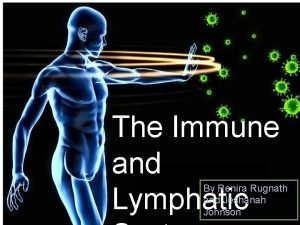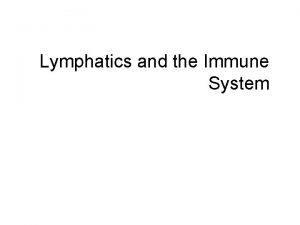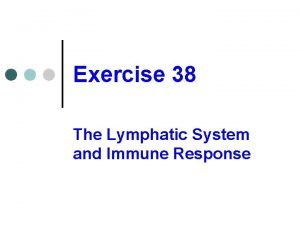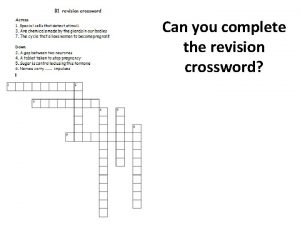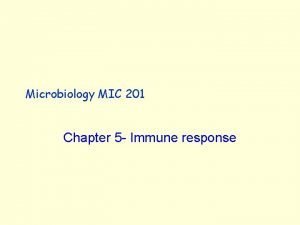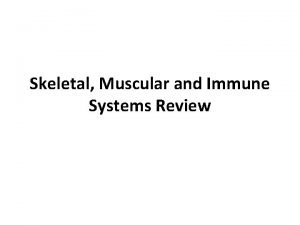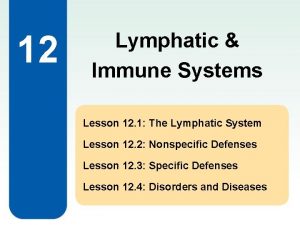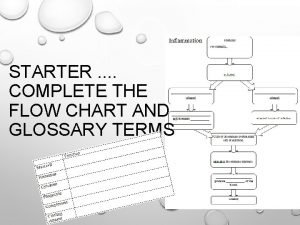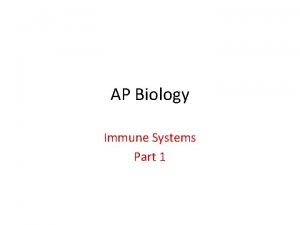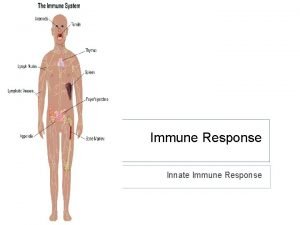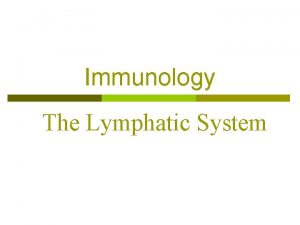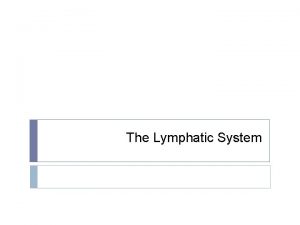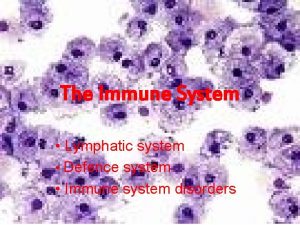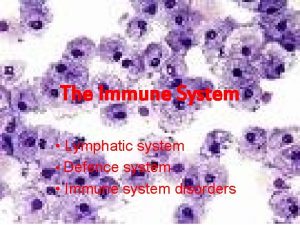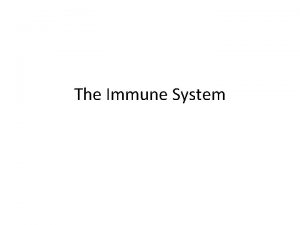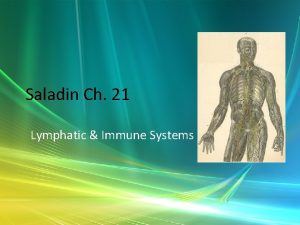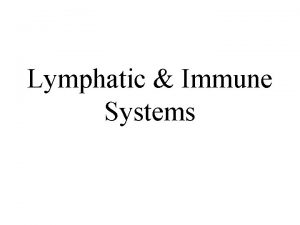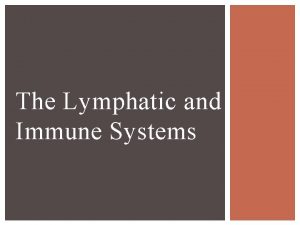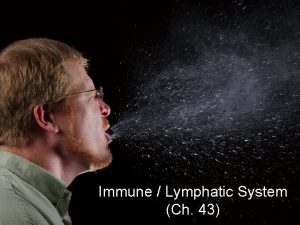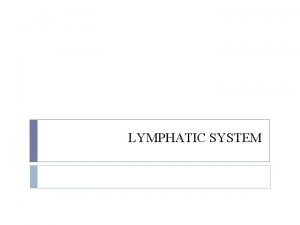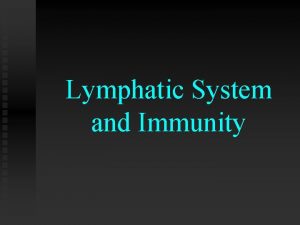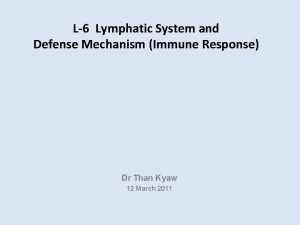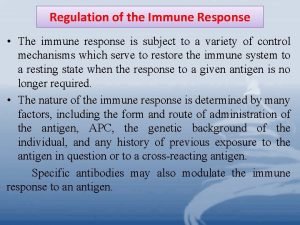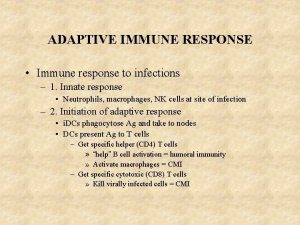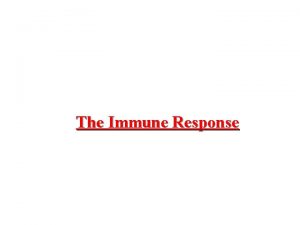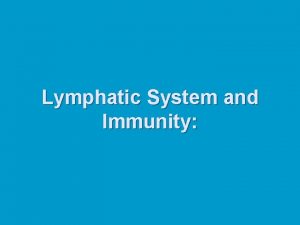Exercise 38 The Lymphatic System and Immune Response

























- Slides: 25

Exercise 38 The Lymphatic System and Immune Response

Lymphatic System Lymphatic vessels ¢ Lymphatic tissues l Tonsils ¢ Primary lymphatic organs l Thymus and Bone marrow ¢ Secondary lymphatic organs l Lymph nodes, spleen ¢

Lymphatic System

Lymphatic System Lymph l Fluid lost from the capillaries l Edema ¢ Functions of the lymphatic system: l Transport lymph to the blood vessels l Protects the body ¢

Lymphatic vessels Lymphatic capillaries ¢ Lymphatic collecting vessels ¢ Lymphatic trunk ¢ Right lymphatic duct - drains lymph from: l Head right upper extremity l Right thorax l Drains into right subclavian vein ¢

Lymphatic vessels Thoracic duct – drains lymph from: l Rest of the body l Drains into left subclavian vein ¢ Cisterna chyli ¢ Characteristic of the lymphatic vessels l Walls with 3 tunics l Presence of valves l Presence of abundant anastomoses ¢

Lymphatic vessels

Primary lymphoid organs Bone marrow l Contain the stem cell that will give rise to all lymphocytes l Site of B cell differentiation or immunocompetency ¢ Thymus l Site of T cell differentiation or immunocompetency ¢

Thymus

Secondary lymphatic organs ¢ Lymph nodes l Bean-shaped l Numerous l Regional lymph nodes: • Cervical • Axillary • Inguinal, etc l Hilus l Afferent and efferent vessels

Secondary lymphatic organs ¢ Microscopy l Capsule and subcapsular sinus l Trabecula l Cortex • Outer cortex (follicles) • Germinal center containing dividing B cells • Deep cortex or paracortical area • Contain T cells

Secondary lymphatic organs l Medulla • Medullary cords • Medullary sinuses • Contain macrophages and plasma cells

Secondary lymphatic organs ¢ Spleen l Capsule l White pulp • Central artery • Lymphocytes l Red pulp • Venous sinuses • Reticular tissue • Macrophages arranged I splenic cords

Spleen

Lymphoid tissues ¢ Tonsils l One pharingeal l Two palatines l Two linguals l Presence of germinal center l Presence of crypts

Tonsils

The immune response It is a systemic response ¢ Destroys or neutralizes foreign substances ¢ Characteristics of immune responses l Memory • Immunocompetent lymphocytes are monospecific l Specificity l Ability to differentiate self from nonself ¢

The immune response Antigens l Foreign proteins l Polysaccharides l Haptens ¢ Lymphocytes l Responsible for the immune response ¢ Autoimmunity ¢

Organ, cells and cell interaction of the immune response Hemocytoblasts in the bone marrow give rise to lymphocytes ¢ Types of Lymphocytes: l B - will stay in the bone marrow for maturation (immunocompetence) l T - will migrate to thymus for maturation (immunocompetence) l Natural Killers ¢

Organ, cells and cell interaction of the immune response ¢ B and T cell will then leave bone marrow and thymus, enter the blood stream and travel to secondary lymphatic organs l Site for clonal selection

Organ, cells and cell interaction of the immune response B and T cell will bind to specific antigens and then undergo clonal multiplication ¢ B cell may become l Memory l Plasma cell l Humoral immunity ¢

Organ, cells and cell interaction of the immune response ¢ T cell may become l Memory l Cytotoxic l Helper l Suppressor l Cellular immunity

Antibodies and tests for their presence ¢ Characteristics of antibodies or Immunoglobulins (Igs) l Produced only by plasma cells l They are plasma proteins (gamaglobulins) l Found in all body secretions

Antibodies and tests for their presence Classes of antibodies l Ig. M, Ig. G, Ig. A, Ig. D, Ig. E ¢ Structure of the immunoglobulins l 2 heavy chains l 2 light chains ¢

Antibody
 A subsequent
A subsequent Lymphatic vs immune system
Lymphatic vs immune system Lymph return
Lymph return Chapter 24 the immune and lymphatic systems and cancer
Chapter 24 the immune and lymphatic systems and cancer What empties into the left subclavian vein
What empties into the left subclavian vein Exercise 38
Exercise 38 Primary and secondary immune response
Primary and secondary immune response Difference between innate and learned behavior
Difference between innate and learned behavior What is the third line of defense in the immune system
What is the third line of defense in the immune system Any substance capable of provoking an immune response
Any substance capable of provoking an immune response Primary immune response
Primary immune response Immune response controller crossword
Immune response controller crossword Biosimilar study
Biosimilar study Cellular immune response
Cellular immune response Muscle type
Muscle type Lymphatic system
Lymphatic system Chapter 35 immune system and disease
Chapter 35 immune system and disease Lesson 12.1 lymphatic ducts and vessels
Lesson 12.1 lymphatic ducts and vessels Lesson 12 blood and immune system
Lesson 12 blood and immune system Malt tonsils
Malt tonsils Muscular system response to exercise
Muscular system response to exercise Lympathic
Lympathic What is the third line of defense in the immune system
What is the third line of defense in the immune system Flow chart
Flow chart Second line of defense immune system
Second line of defense immune system Ap bio immune system
Ap bio immune system

